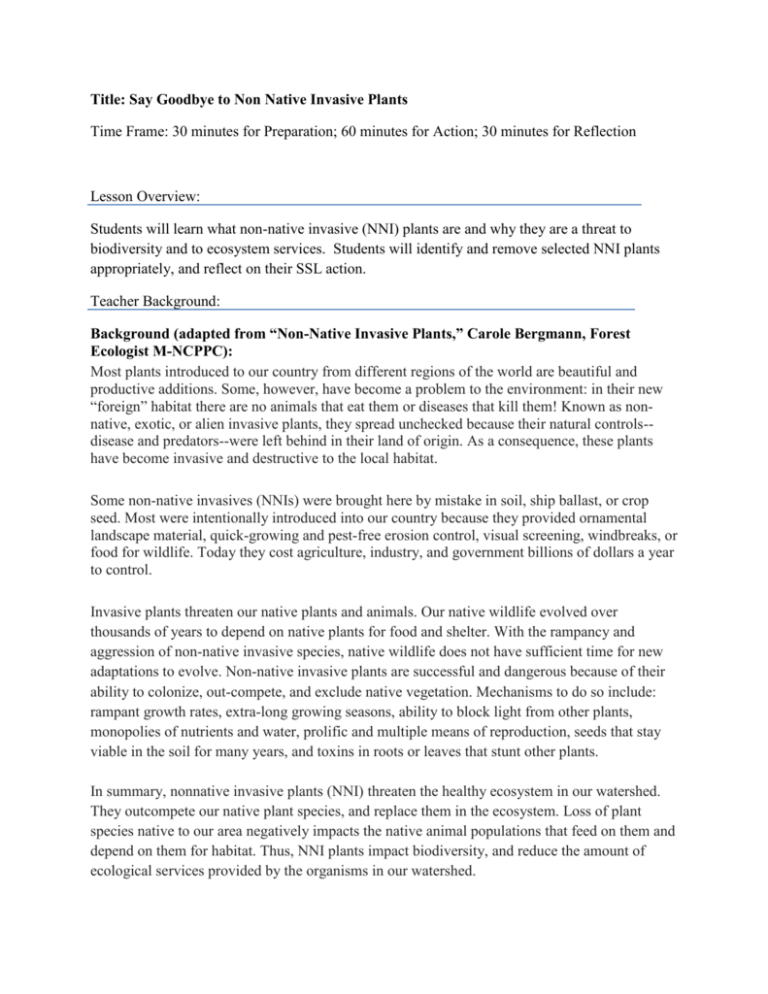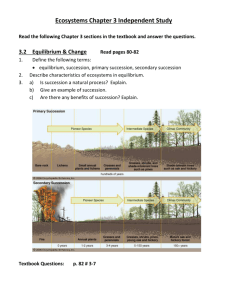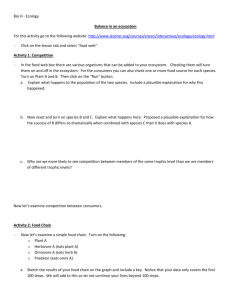Say Goodbye to Non Native Invasive Plants
advertisement

Title: Say Goodbye to Non Native Invasive Plants Time Frame: 30 minutes for Preparation; 60 minutes for Action; 30 minutes for Reflection Lesson Overview: Students will learn what non-native invasive (NNI) plants are and why they are a threat to biodiversity and to ecosystem services. Students will identify and remove selected NNI plants appropriately, and reflect on their SSL action. Teacher Background: Background (adapted from “Non-Native Invasive Plants,” Carole Bergmann, Forest Ecologist M-NCPPC): Most plants introduced to our country from different regions of the world are beautiful and productive additions. Some, however, have become a problem to the environment: in their new “foreign” habitat there are no animals that eat them or diseases that kill them! Known as nonnative, exotic, or alien invasive plants, they spread unchecked because their natural controls-disease and predators--were left behind in their land of origin. As a consequence, these plants have become invasive and destructive to the local habitat. Some non-native invasives (NNIs) were brought here by mistake in soil, ship ballast, or crop seed. Most were intentionally introduced into our country because they provided ornamental landscape material, quick-growing and pest-free erosion control, visual screening, windbreaks, or food for wildlife. Today they cost agriculture, industry, and government billions of dollars a year to control. Invasive plants threaten our native plants and animals. Our native wildlife evolved over thousands of years to depend on native plants for food and shelter. With the rampancy and aggression of non-native invasive species, native wildlife does not have sufficient time for new adaptations to evolve. Non-native invasive plants are successful and dangerous because of their ability to colonize, out-compete, and exclude native vegetation. Mechanisms to do so include: rampant growth rates, extra-long growing seasons, ability to block light from other plants, monopolies of nutrients and water, prolific and multiple means of reproduction, seeds that stay viable in the soil for many years, and toxins in roots or leaves that stunt other plants. In summary, nonnative invasive plants (NNI) threaten the healthy ecosystem in our watershed. They outcompete our native plant species, and replace them in the ecosystem. Loss of plant species native to our area negatively impacts the native animal populations that feed on them and depend on them for habitat. Thus, NNI plants impact biodiversity, and reduce the amount of ecological services provided by the organisms in our watershed. Wineberry *All months * Native to Japan, Korea, China *Introduced in 1890 to combine with raspberry and blackberry species *3 heart-shaped leaves white underneath, stem has reddish hairs and small spines *Deer don't eat it and birds spread the seeds Mile-a-Minute *April and May *Native to Asia *Stems are armed with curved barbs which are also present on the underside of the leaf blades *Can grow up to 6 inches a day, scrambling over shrubs and other vegetation, blocking the foliage of covered plants from available light, and reducing their ability to photosynthesize *The weight and pressure of the vine causes distortion of stems and branches of covered plants Garlic Mustard *March and April *Native to Europe *One of the few nonnative plants capable of invading and dominating forest understory *Tolerant of low light levels, has high seed production and able to spread rapidly *Competes with native spring woodland plants such as spring beauty, trout lily, jack-in-thepulpit, violets, golden ragwort *The deer don’t eat it! Stilt Grass *April, May, and June *Native to Japan, Korea, China, Malaysia and India *Invades and alters disturbed soils in sun or shade *Produces seed banks which stay viable in the soil for years *Came here because it was used in packaging as a natural bubble wrap, AKA “Japanese Packing Grass” Enduring Understanding & Essential Questions: Enduring Understanding: Natural resources need protection and conservation in a given environment. Biodiversity is a natural resource. Essential Question: How can people help maintain and increase biodiversity in their local environment? Next Generation Science Standards: Science and Engineering Practices Engaging in Argument from Evidence Evaluate competing design solutions based on jointly developed and agreed-upon design criteria. Disciplinary Core Ideas Crosscutting Concepts Interdependent Relationships in Ecosystems Stability and Change In any ecosystem, organisms and populations with similar requirements for food, water oxygen, or other resources may compete with each other for limited resources, access to which consequently constrains their growth and reproduction. Small changes in one part of a system might cause large changes in another part. Biodiversity describes the variety of species found in Earth’s terrestrial and oceanic ecosystems. The completeness or integrity of an ecosystem’s biodiversity is often used as a measure of its health. Performance Expectation MS-LS2-5 Evaluate competing design solutions for maintaining biodiversity and ecosystem services. (Clarification Statement: Example of ecosystem services could include water purification, nutrient recycling, and prevention of soil erosion. Examples of design solution constraints could include scientific, economic, and social considerations.) Maryland Environmental Literacy Standards STANDARD 1 ENVIRONMENTAL ISSUES The student will investigate and analyze environmental issues ranging from local to global perspectives and develop and implement a local action project that protects, sustains, or enhances the natural environment. Topic A: Environmental Issue Investigation Topic B. Action Component Indicator 1: Use recommendation(s) to develop and implement an environmental action plan. Indicator 2: Communicate, evaluate and justify personal views on environmental issue and alternate ways to address them. Indicator 3: Analyze the effectiveness of the action plan in terms of achieving the desired outcomes. STANDARD 4 POPULATIONS, COMMUNITIES AND ECOSYSTEMS The student will use physical, chemical, biological, and ecological concepts to analyze and explain the interdependence of humans and organisms in populations, communities and ecosystems. Topic B: Population Dynamics Indicator 1: Analyze the growth or decline of populations and identify a variety of responsible factors. Topic C: Community and Ecosystem Dynamics Indicator 1: Explain how the interrelationships and interdependencies of organisms and populations contribute to the dynamics of communities and ecosystems. 5E Lesson Engage: (Preparation) Ask students: “How can a plant “escape” from where it is? If it can escape, can a plant “invade?” Are there “bad” plants? Discussion should include that plants are beneficial – they are all producers and part of healthy ecosystem, but there are plants that can have some serious negative impacts on humans and on the environment in which we live. Plants might cause allergies, poison people if eaten, and some even take over entire habitats crowding out all the native plants. Today, we are going to do something about that last type of plant that is growing out of control – the non-native invasive. It is a serious threat to our local environment. Explain: (Preparation) Option 1: Use the NNI PowerPoint. Option 2: Discuss and provide information: (See Teacher Background) What is meant by a “non-native invasive plant?” Why are such plants harmful to a local ecosystem? Why is removal of NNI plants beneficial to the environment? Demonstration and Modeling: Identify at least one non-native invasive plant Show how to remove it. Reminder: Explain and show what poison ivy looks like. Explore: (Action) 1. Divide students into groups and assign each group a specific area within the larger removal zone. Share the identification guides with the groups. 2. Review the removal techniques and instructions. Removal Tips Pick EVERY visible plant with stems It's better to get every plant from one place than to get most plants from two places. Leaving a plant is like sowing a hundred seeds. If stems frequently break at the root, wiggle the stem before pulling. Search a bit for a broken root and remove. Be prepared to pick with little talking - it takes concentration to get every plant! When stems grow closely in loose soil, gather several with one hand motion. 3. Return equipment at the end of the session! Account for all equipment and return to the proper location. Preparation Notes for the Teacher: Before you come to OE: 1. Meet with your coordinator ahead of time to become familiar with the NNI students will be removing and how it will be removed. 2. Introduce SSL using the SSL power point, and introduce this NNI Removal project to your students using our OEEP SSL PowerPoint (Explain) 3. Provide safety guidelines to students about poison ivy: Wear long sleeves and long pants Remember “leaves of three, let it be" is a good rule of thumb Leave hairy vines alone, too! Poison ivy is active in winter – avoid hairy vines At Outdoor Ed: Gather equipment: 1. Carts for transporting the pulled weeds, if necessary for the selected NNI: located near greenhouse 2. Shovels, clippers, saws and pitchforks that might be necessary for removing selected NNI: located in locked cage next to greenhouse 3. Work Gloves Evaluate: (Reflection) Prepare students for their writing by asking them to talk with an elbow partner about: What did you learn about non native invasive plants that you did not know before? How did this SSL work help the environment? (i.e. what need did your service address) Who or what benefitted? Have students write their answers to the following SSL form questions in their notebooks: 1. What did you do? 2. What need did your service address? 3. Who benefitted from your service? 4. What did you learn about yourself? 5. How was this experience connected to something you learned in a class at school? (For example, English, Mathematics, Science, Social Studies, Arts, Physical Education, Health, Foreign Language, etc.) Determine how you will group students and which adults will be responsible for each group. Walk adults for each group to selected locations for NNI removal and demonstrate techniques to identify the plant and how to remove it. This must be done sometime before the class is scheduled to begin.










